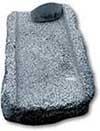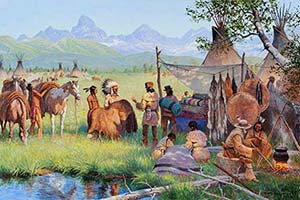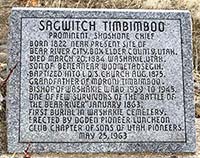Discovery of Cache Valley ~ Index

The Discovery of Cache Valley and the Trapping Period.
It was less than three score and ten years ago, the traditional span of one human life, that white people began to build homes in Cache Valley. Less than forty years before that time the valley had first been seen by white men. Our knowledge of what happened here before that time is very much limited indeed. Let us see what are some of the things we may imagine, based on what we know. Vast expanses of time must have elapsed between the time when Cache Valley was a bay of that great inland sea known today as Lake Bonneville and the coming of human beings to occupy the region. A shorter but still a very great period must have gone by during which the red man (or the red man and his predecessors) roamed here at will.
During this latter period, what was the manner of life of these human beings? A few years ago there was found a curious bit of evidence that furnishes a likely answer in a very slight degree to this question. This relic of the past is a strange looking corn grinder, neatly carved out of volcanic rock. It was found at Benson, a few feet beneath the surface of the ground. This is not certain proof, of course, that the primitive peoples of the valley lived by tilling the soil, or that they even tilled the soil for part of their living. But it is a fair inference that they very probably did. Also, if these people raised corn, it may be that they practiced the art of irrigation. Ruins of ancient canals in other parts of Utah have strengthened these inferences.
But why if these people were farmers, did they sink into a less advanced mode of life? If we suppose that during the agricultural stage no buffalo made the region its feeding ground and that the animal came in great numbers, a satisfactory answer on the whole is found. For the buffalo would injure growing crops and above all, tempt other tribes to the region as they followed their food supply and above all, would furnish an available source of food without the labor and uncertainty of raising it.

Be these suppositions idle or not, we know that at one time, hunting the buffalo was the main occupation of the savages who roamed over the valley. They also hunted other animals, such as elk, the antelope, the deer, the bear, the Rocky Mountain sheep and the game birds on both water and land. They also fished, dug roots and gathered the serviceberry, the wild cherry, the wild currants, gooseberries, and other fruits. These things the Indian was doing as he wandered from place to place when the pioneers came to the valley, all except one. That was to hunt the buffalo. For this former mainstay of the Indians' existence has disappeared from the valley and had disappeared suddenly, according to Indian traditions.
This is the story told by an Indian, Chief Sagwitch*, to the first settlers of Cache Valley. At the time of the telling, Sagwitch was seventy-five or eighty years old, thus making his birth about 1780. He says that when he was in his fourth year, the snow began to come early in the fall to such a depth that the Indians became alarmed and began to move out of the valley and into the valley west. By doing this, they saved their lives, for all winter the snow continued to pile up in the two valleys until even in Salt Lake Valley it reached the depth of about fourteen feet and in Cache Valley it was worse. In the spring when the Indians returned to this valley they counted but seven live buffaloes. These they gave chase to, killing some and the others fled and disappeared out of the valley to the north.
Whatever exaggeration there is to this story, it is quite evident that some sudden calamity must have overtaken the buffaloes, for the pioneers found here great piles of their bones, as they did the bones of the deer and elk. And that this calamity was occasioned by a severe winter about 1785, there is no good reason to doubt. After this loss of so valuable a source of food supply, life for the Indian in Cache Valley was not quite as pleasant as it had been. However, their habits were not essentially changed. With their bows and arrows as weapons, clad in scanty or no clothing, they migrated from place to place, sometimes following the game into the mountains in the summer and returning to the valley for the winter, or even taking longer journeys into other valleys, to the west and north especially.
Their religion was a superstitious fear of unseen forces. Their customs were crude, as for example one described to the writer by one of the first settlers of the valley. On the death of a brave, the women members of the household followed the custom of slashing with a knife three cuts on the leg, three cuts on the arm, and then would set up a dismal wailing until the wounds were healed. Yet these simple folk were not as horrible as we sometimes imagine. They lived in bands of several hundred or a few thousands under various chiefs who in turn were subordinate to a greater chief, the head of the nation to which they belonged— the Shoshonean. And they were at peace among themselves. They were engaged in incessant warfare with the Indians to the south of Weber River, the Utahs. But in that they were in reality no different than the great-civilized peoples of the world today.
Their morality was comparatively high, as far as their enlightenment permitted. One of the early settlers of the valley made this remark to the writer: "They were more honest than the whites. The story of the supplanting of the Indian by the whites, when rightly considered, is a tragedy, sad, but inevitable. The first connection between these "Children of the Soil and the white intruder was indirect. The Utahs (Ute's) in the early part of the nineteenth century were accustomed to make raids upon the Shoshone of Cache Valley to obtain slaves to sell to the Spanish slave traders from the south.

The discovery of Cache Valley by white men was brought about when these men were hunting for un-trapped rivers and creeks where the beaver might still be found. Beaver furs were used to make the famous beaver hat and beaver skins were bringing six dollars a pound. One beaver skin weighed about two pounds. In the summer of 1824 trappers belonging to the Rocky Mountain Fur Company, of which General William Ashley was the head, pushed through the South Pass to Green River and thence to the head waters of Bear River, which they discovered and named. Down the Bear River they traveled until they reached Cache Valley. Here they prepared to winter. Thus, 1924 will be the One Hundredth Anniversary of Cache Valley.
This company of trappers was under the direction of one William Sublette. James Bridger, or Jim Bridger as he was called, was one of them. There was a man named Williams, one named (Robert) Campbell, and a score of other white men. There were also many Indians, men, women and children, and possibly some half-breed children, who accompanied the whites. These first-comers seem to have called the valley "Willow Valley" at first. But not long after the discovery, these men began to cache their furs here, probably in 1825 and soon they began to refer to the valley as Cache Valley.
Beginning with the spring of 1825, the trapping of the beaver became an important human activity in the newly discovered valley. White men thoroughly explored and named all the streams suitable for trapping. In these operations they did not disturb the red man's means of subsistence and hence the two people were on friendly terms.

Among these trappers we read of one James P. Beckwith who was here in 1825 and subsequently. He speaks of the death of two of the men caused by the cave-in of a bank as they were caching their furs, and the burial of these men by the Indians in the Indian fashion and upon poles. He also tells of the accidental shooting by a trapper of an Indian who was trying to stalk antelope dressed in an antelope skin.
There was another trapper, Osborne Russell by name, who writes of his visits to the valley, once in 1824 and again in 1840. In the first visit, a small company of trappers under the leadership of one Joseph Gale, crossed the mountains by going up a creek they called Rush Creek, which was located in the extreme southeastern corner of the valley. From there they went over the divide into the valley to the east where they camped on a lake known as Snake Lake. In the visit of 1840, Russell found several French and half-breed trappers. Another trapper who was in the valley before 1847 was a certain Major Harris who met Brigham Young and the pioneers before they came into Salt Lake Valley. Harris, in answering inquiries concerning the region of the Great Salt Lake, gave it to be his opinion that Cache Valley was a much more desirable place in which to live than Salt Lake Valley.
There was, in all probability, not a year between 1824 and 1847 when the valley was not visited by some company of white men with their Indians wives and allies and half-bred children. In return for the furs they took away, they left what? Well, for one thing they left a few names. We have already spoken of the naming of Bear River. Other names familiar today that these trappers must have been responsible for are, the Muddy River (Little Bear River) in the south part of the valley, Blacksmith Fork, Logan River and High Creek.
Notes…

*Sagwitch is noted to have been born in about 1822 on the lower Bear River, near Corinne over in Box Elder County, Utah. So this statement from above, regarding the deep snow and loss of the Buffalo in Cache Valley, is perhaps credited to either the wrong person, or from a older man and thus just passed down to us incorectly. I would offer Bear Hunter, as perhaps the Indian Chief whom offered this early information to the people of Cache Valley.
The corn grinder noted above, and found in Benson would be from the Fremont Culture that predated the Shoshone incursion into Cache Valley. They had learned to grow some crops, among which was corn or maze. A Shoshone Metate & Mano were much smaller and of much finer rock, they were to grind the grass seeds that grew with abundance in the valley at one time. An example of both types can be found on the Landmark and Trails/DUP marker at Battle Creek, north and west of Preston, Idaho along the highway. The smaller one on the west face is Shoshone, the south one is older and so perhaps from the Fremont Culture.
The Shoshone people at one time controlled the prime buffalo hunting areas, just east of the Rocky Mountains. They were "Walkers" at first, but were able to acquire the horse, from their southern kin, the Comanche. With the introduction of the horse they developed excellent equestrian skills and ruled the western and north portion of the Great Plains for quite a while. Their kin, the Comanche ruled the southern plains.
The Shoshone restricted horse trading to only their friends, not wanting their enemies to procure the advantage they had received. But over time the Blackfeet and other enemies were able to also abandon their pedestrian ways, but in addition to the horse, they now had firearms. With guns they pushed the Shoshone back into the intermountain west, and away from the herds of bison that for many years had become their mainstay.
The Shoshone were the most feared Indian group on the Great Plains at one time. They acquired some of the ways and traditions of the other groups they encountered on the plains. So a scaffold burial, as noted above could have certainly occurred.
Also see: The Distribution of the Horse and Bison with map from 1500 to 1850.